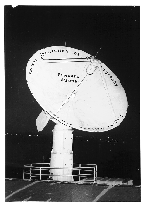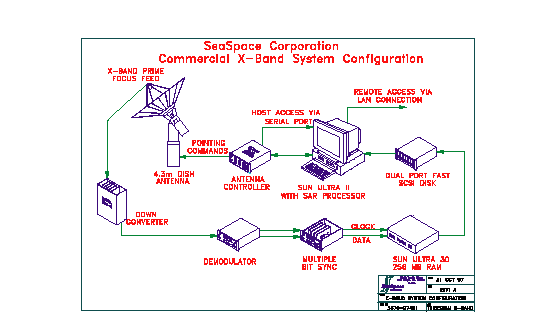Development of
X-Band Downlink Facility
Dr. Robert L. Bernstein and Dr. Kota Prasad - SeaSpace
Corporation
Dr. David Sandwell and Dr. Bernard Minster - Scripps
Institution of Oceanography
Contents:
Objectives
 To
routinely acquire SAR data from passes across the San Andreas fault zone
in Southern California in order to to monitor crustal deformation in this
tectonically-active area.
To
routinely acquire SAR data from passes across the San Andreas fault zone
in Southern California in order to to monitor crustal deformation in this
tectonically-active area.- To integrate Interferometric SAR
data with an array of 150 continuously-operating GPS recievers to increase
the accuracy of the interferogram. This involves the deployment of radar
corner reflectors at selected GPS sites to aid the calibration of the phase.
- To acquire SAR data along coastal areas of California
and Baja California in order to to study mixing processes in the California
Current.
- To extend the overall coverage
of ERS-2 to include a large portion of Mexico and much of the Eastern North
Pacific Ocean. In addition regular acquisition over southwestern North
America would reduce the burden at the Prince Albert, Canada site enabling
them to improve their coverage of Arctic areas.
Overall Plan
SIO is currently developing an X-band down-link facility,
located on the SIO campus, by upgrading an existing
5-m satellite dish and electronics. In the past, X-band data acquisition
been done with a larger dish antenna (~10 m) and at a much higher cost.
Thus some engineering R&D is needed
to compensate for the smaller aperture by taking advantage of state-of-the-art
electronic technology. SeaSpace Corporation, San Diego, CA is developing
the acquisition hardware and software. Both SeaSpace and SIO scientists
are developing the SAR processing software and SAR data distribution system.
NASA (50%), the State of California (25%) and SeaSpace/SIO (25%) are funding
this project. The funding for the system is now complete and construction
is in progress. The overall tasks follow:
- SIO provides the existing 5-m Scientific Atlanta dish
as well as a small building adjacent to the antenna. Some funding from
the SIO director's office have been used for refurbishing the antenna and
building as well as other infrastructure items such as network connections.
(completed 5/96)
- SIO provides office space for SeaSpace personnel, network
access and some access to other major computer items like mass storage
devices. (completed 12/96)
- SeaSpace provides the technical expertise to design and
construct the facility. This involves upgrading the antenna and tracking
system, selecting; the antenna feed, the low-noise amplifier, the bit synchronizer,
and the specialized boards for process and storage of the data. (Dr. Kota
Prasad is the SeaSpace engineer working on the project).
- SeaSpace and SIO will work together on developing
the SAR processor and interferometric code as well as the systems for
data archive, data processing, and data distribution. A re-write of a Stanford/JPL
SAR processor from FORTRAN to C is fully tested. The 8-terabyte Storage
Technology disk/DLT system at IGPP is archiving a variety of geophysical
data. The intent is not to become a major data acquisition and archive
facility that will service all scientific/commercial needs in western North
America. Instead we wish to acquire the most scientifically interesting
data sets. The SIO X-band downlink will acquire data from EOS-AM1 and other
high data rate satellites.
SBIR
Phase II Progress Report - December 1997
SBIR PHASE-II CONTRACT NAS 8-97041
CONTRACT PERIOD OF PERFORMANCE: 01 September 1997 - 30
November 1997.
AUTHOR: Dr. Kota Prasad - SeaSpace
Co.
CONTRACT TITLE:
LOW-COST X-BAND SATELLITE DATA ACQUISITION SYSTEM
FOR RADARSAT, EOS, AND BEYOND
 I. Upgrade of Scripps Satellite Antenna and Facility
The following developments have occurred since the last
progress report was submitted.
I. Upgrade of Scripps Satellite Antenna and Facility
The following developments have occurred since the last
progress report was submitted.
- i. New Cables and Connectors - New cables and
connectors were installed since the last reporting period. New 1/2 ( Hiliax
cables (LDF4-50A) were installed between the X-band feed and the new downconverter.
New bulk-head connectors were installed for connecting the cables between
the feed and the pedestal. The signal gain at the feed and downconverter
were tested for eliminating possible electronic interlocks. Antenna azimuth
and elevation commands were issued to insure that the hiliax cables did
not wrap around and attenuate the signal.
- ii. Antenna sun alignment
and tracking adjustments - Sun alignment was performed on the antenna.
The shadow of the X-band feed on the center of the dish was clearly marked
for making measurements of the feed offset. Using these measurements coefficients
were computed in degrees and later integrated into the antenna control
software. This exercise improved the pointing accuracy to a considerable
extent. Further changes in the antenna control software were made to minimize
the antenna lag during elevation.
- iii. Signal generator - A HP signal generator
was installed for generating the local oscillator (LO) frequency required
for stabilizing the downconverter. The reference frequency was determined
as follows: LO (MHz) = RF(MHz)-375/75 Where RF is the downlink frequency
in MHz for the desired X-band telemetry, 375 is the IF frequency, and 75
is the multiplier for the reference input. The LO for ERS-2 and RADARSAT
were computed as 103.53 MHz and 103.06 MHz respectively. The external LO
reference level at the downconverter was set at 0.0 dBm(3.0 dBm.
- iv. RF integration - The X-band demodulator, bit-synchronizer,
and the HP signal generator were mounted on a vertical chassis. The chassis
was fitted with an exhaust fan on the top panel and a air-blower at the
bottom for cooling the system. The bit-synchronizer was installed with
a plug-in module for RADARSAT/ERS-2. The downconverted RF signal was used
as input to the demodulator. The clock and data from the bit-synchronizer
was used for testing the signal strength.
- v. ERS-2 and RADARSAT
tracking - The Sun-Ultra-II workstation has been setup to receive
updated orbital elements for ERS-2 and RADARSAT satellites once every day.
Passes were scheduled for ERS-2 satellite initially and later RADARSAT
was added to the list. We achieved demodulator and bit-synchronizer signal
lock for both ERS-2 and RADARSAT satellites. A spectrum analyzer was used
for observing the signal peak, and a printer was used for copying the signal
peak at various elevations. We were particularly interested in observing
the elevation angle when a solid signal lock was on the bit-synchronizer.
We enclose representative plots of the spectrum analyzer output both for
ERS-2 and RADARSAT recorded during our recent tracking tests. The plots
show adequate gain above the normal for both the satellites.
II. High-Speed Frame Synchronizer
- The development of the high-speed frame synchronizer
that can handle data rates up to 150 Mbps is 90% complete . Four PC boards
have been fabricated. Tests have been completed for writing data to disk
using the Simbios SCSI processor. Instead of a Sun Ultra-II, we plan to
take advantage of the new Sun Ultra 30 workstation for integrating our
frame-synchronizer. The Sun Ultra 30 offers 4 full-sized PCI 32-/64-bit
slots and has a clock speed of 296 MHz. We plan to use simulated data to
test the 150 Mbps frame synchronizer.
III. User Systems SAR Processor Software
- The initial version of the SAR processor had the capability
to ingest and process only ERS-1 and ERS-2. Recently, a RADARSAT front-end
parser has been added to SAR processor. Other features added to the processor
include raw data ingest from CD-ROM and ingestion of raw data in CEOS data
format.
IV. Future work
- We will concentrate on testing the frame-synchronizer
extensively. Frame formats for both ERS and RADARSAT will be used to program
the frame-synchronizer. Testing will also continue for handling rapid disk
write code using raw synthetic data generated at a data rate of 150 Mbps.
Once we are satisfied with the frame-synchronizer's ability to handle high
data rates, we will input clock and data from the bit-synchronizer and
test the framing capability of the system. This will form a critical step
in our system integration and we expect to complete testing during the
first quarter of 1998.
 To
routinely acquire SAR data from passes across the San Andreas fault zone
in Southern California in order to to monitor crustal deformation in this
tectonically-active area.
To
routinely acquire SAR data from passes across the San Andreas fault zone
in Southern California in order to to monitor crustal deformation in this
tectonically-active area. To
routinely acquire SAR data from passes across the San Andreas fault zone
in Southern California in order to to monitor crustal deformation in this
tectonically-active area.
To
routinely acquire SAR data from passes across the San Andreas fault zone
in Southern California in order to to monitor crustal deformation in this
tectonically-active area.